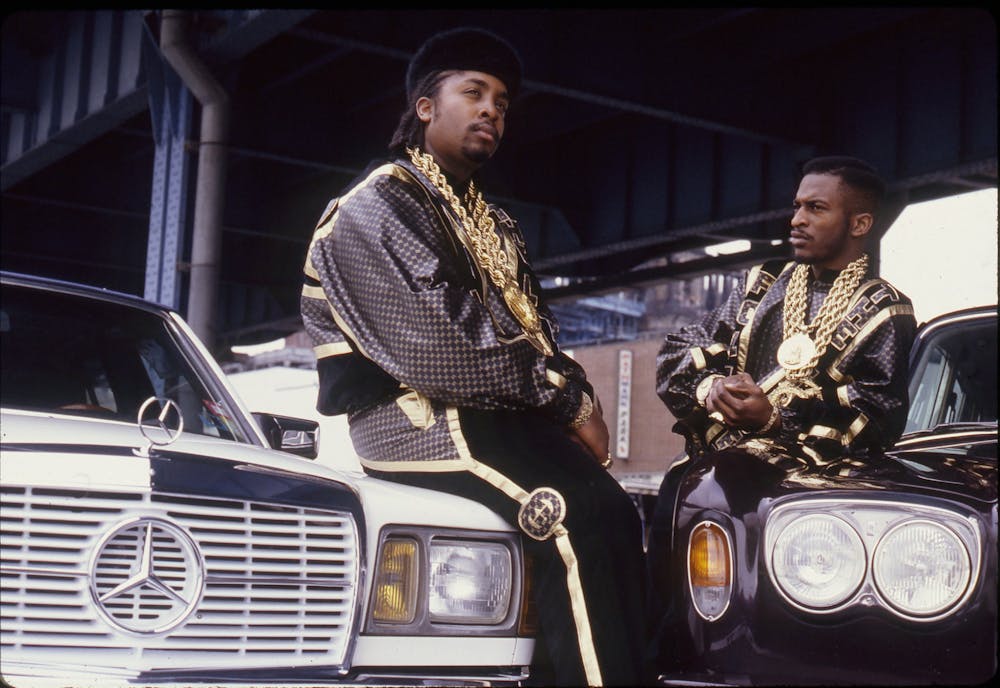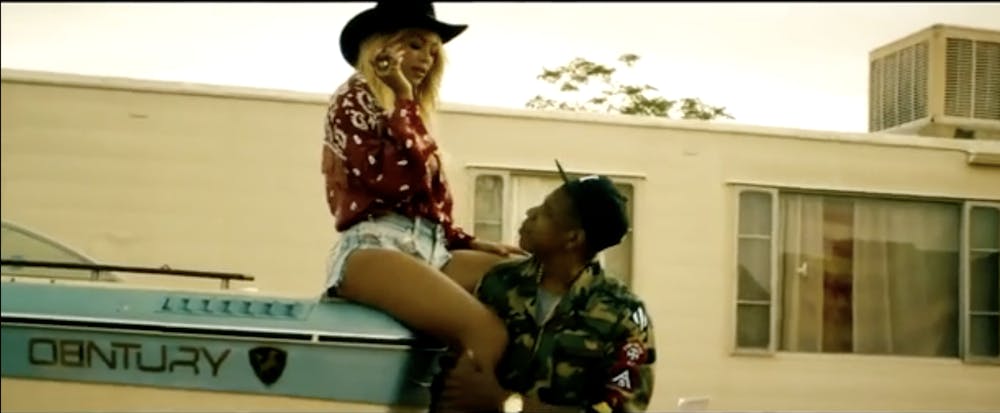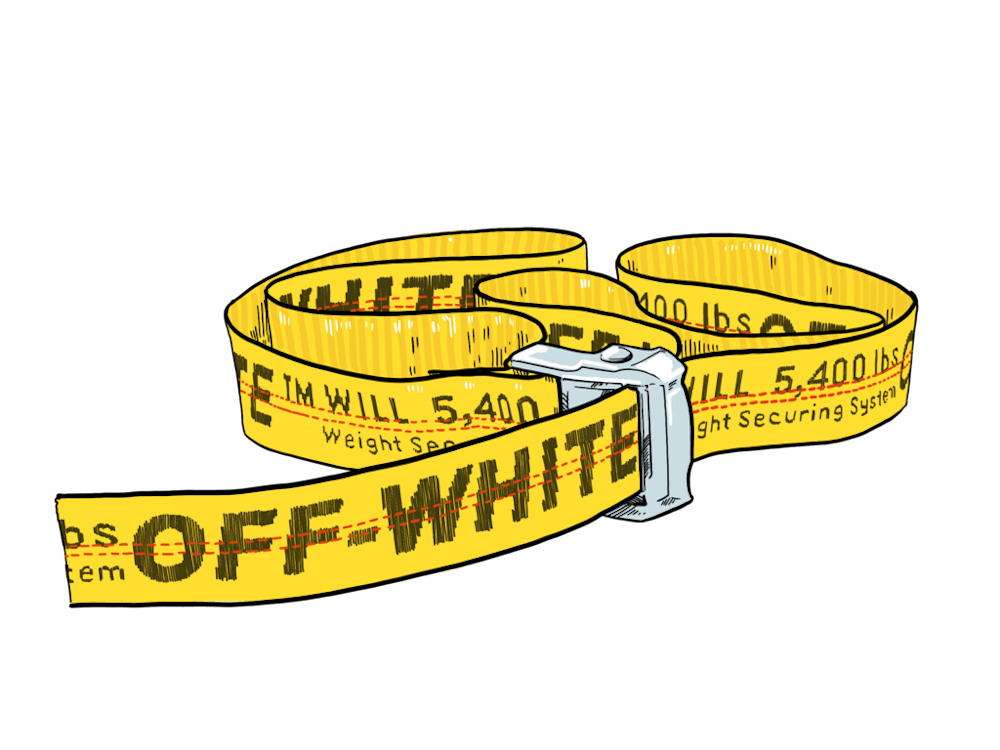Industrial themed belts with no explicit function. Thousand dollar white sweatshirts. Garments accentuated only by their item names in quotation marks.
Off–White is one of the world’s most popular luxury brands— and its predominant aesthetic appears to be irony.
Since its founding in 2013, Off–White has amassed popularity at an almost exponential rate. The brand’s creator, Virgil Abloh, attributes its success to a “public that is now prime to support brands.” Beyond a generation of customers that appreciates niche brand identity, however, there are a variety of cultural and historical factors at play that imbue Abloh’s brand with a great deal of significance— and, perhaps, can both explain and warrant its current status.
Currently, Off–White lies at the crux of an incredibly profitable trifecta: the growing market for luxury goods amongst younger consumers, the popularity of hip hop in the United States, and the demand for streetwear. This narrative, however, is not entirely novel. The roots for Off–White can be traced to a small corner store in Harlem, belonging to the couturier Dapper Dan.

Dapper Dan is often referred to in iconoclastic terms. Far from being hyperbolic, descriptions of him as the ‘designer who curated hip hop culture’ or the ‘original auteur of gangster chic’ ring true. Born Daniel Day, he opened ‘Dapper Dan’s Boutique’ in 1989, in the midst of hip hop’s meteoric rise within pop culture. Yet, while rap coveted the exclusivity of luxury fashion, haute–couture brands shunned any such association with hip–hop artists for fear of alienating their target demographic. In response, Dapper Dan created one–of–a–kind counterfeits of upmarket brands, repurposing their logos and styles into extravagant, audacious original designs.

Analogous to hip–hop itself, Dapper Dan’s work ‘sampled’ haute–couture: printing Louis Vuitton, Fendi, and Gucci’s monograms onto premium leathers and combining them with unusual textures, such as ostrich and mink. Rather than being ‘knockoffs’ or simple counterfeits, Dapper Dan’s designs created an entirely new tier of elite fashion—that came to be termed ‘knockups’. His customer base reflected the exclusivity of his items: icons such as LL Cool J, Salt–N–Pepper, Daddy Kane, and boxing legend Mike Tyson.
In this way, Dapper Dan first popularized the notion of luxury streetwear. Almost two decades later, Virgil Abloh founded Off–White, a luxury brand that catapulted streetwear into the realm of high fashion that Dapper Dan once sought to emulate.
After receiving a bachelor's in civil engineering and masters in architecture, Abloh opened a boutique called Pyrex Vision in 2012. The brand's central concept was reminiscent of Dapper Dan’s ‘sampling’; Abloh purchased Champion basics and heavily–discounted Ralph Lauren dead–stock, screen–printed his own graphics on top of them, and sold them for hundreds of dollars. The brand was wildly popular, gaining attention from rapper A$AP Rocky, who sported a pair of Pyrex shorts, in his music video Wild For the Night. Despite the controversy surrounding the brand’s craftsmanship and price points, Abloh had made his mark: the year after, he founded Off–White.
Abloh’s architectural background is evident in Off–White’s design philosophy. The iconography pays homage to America’s urban cities: white arrows, diagonal lines, industrial yellow, and black. His designs flaunt streetwear in a unique light, one that he states in the brand’s name and mission statement as ‘defining the grey area between black and white’. Several of hip hop’s most prolific artists, including Jay Z, Kanye West, and Future have worn Off–White in their videos, live performances, or magazine collaborations. Partnerships with brands such as Nike and Ikea have further propelled Abloh’s brand into the limelight, replacing Gucci as Lyst’s ‘hottest brand in the world’ in 2019.

Off–White’s success, however, is matched by criticism. Notably, fashion critic Vanessa Friedman made the argument that "There's a suspicion, somehow, that he is scamming the industry; seeing how far he can exploit its own embarrassing desire for cool, its need for visible diversity, and its lust for his millions of Instagram followers." Others have contended that the brand’s designs lack originality or creativity and that they are a “pallid copy of other people’s ideas." The brand’s primary detractors believe that Off–White has capitalized upon undeserved hype.
The creativity and originality of the aesthetics is bound to be disputed. Fashion is inherently grounded in appropriation and inspiration— the extent to which Abloh does this is certainly up for debate. Fashion is art, and art is controversial.
Moreover, as a luxury streetwear brand, Off–White is susceptible to the numerous criticisms that this particular genre of fashion has faced. Luxury streetwear was a brand borne of couture’s determination to restrict luxury fashion to the predominantly white elite. Yet, the very notion of luxury streetwear seems to be contradictory to its seemingly democratic roots. After all, its high price points render it inaccessible to most of the population, as well as restricting its products to an elite demographic. This is a paradox characteristic of fashion, and other such consumerist art: “While the inspiration in creation might come from the disenfranchised, only the fortunate can make it popular.” Abloh’s desire to “put the skateboard–and–graffiti urban style that comprised his childhood in a revered position” has not manifested itself in his customer base, which comprises predominantly of wealthy millennials.
Off–White can definitely do more to make its products accessible to the very individuals that it draws inspiration from. This is not to say, however, that it has not taken any strides in the interest of democratizing fashion. In 2016, Abloh offered tickets to his fashion show to his followers, to “kids that typically don’t receive invites.” Moreover, in 2018, Off–White released a newer, cheaper collection titled 'For All’ with clothes at lower price points ($95 to $170 as opposed to the traditional $300 to $800 range), to increase the accessibility of his clothing. This particular line sought to expand Off White’s target market and revive the diffusion line for streetwear.
Luxury streetwear, when first popularized by Dapper Dan, acted as a retaliatory genre, drawing inspiration from the very brands that refused an association with hip–hop culture. Given Off–White’s target demographic, it seems paradoxical to characterize it as ‘retaliatory’. However, Off–White remains revolutionary in its own way. Abloh’s brand is representative of the manner in which streetwear has cornered an entire subsect of the luxury market. Off–White brings a renewed sense of reverence to streetwear, by solidifying its place amongst other high fashion brands. There is a clear cultural impact to this: it seems to be in line with Abloh’s own goal of “mak[ing] the demographic he came from more commercially acceptable”. While the brand definitely needs to do more in rendering its creations accessible to those who inspired it, its impact in bringing streetwear into the mainstream of luxury fashion cannot be ignored.

